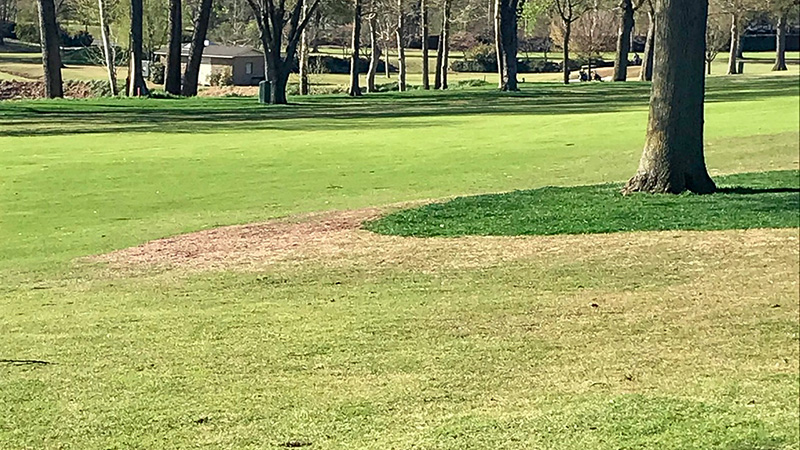
Shade has impacted this fairway and rough adjacent to a large tree at the Tulsa (Okla.) Country Club. Photos by Charles Fontanier
Irrigating turfgrasses under shade can be challenging due to interactions between reduced evaporative demand, stress resistance of the turfgrass and competition for soil water from tree roots (3). Drought tolerance is the plant’s ability to maintain functional cell processes under diminishing leaf hydration, whereas drought avoidance is associated with plant features that prevent leaf dehydration from occurring in the first place (e.g., deeper rooting). During the soil drying process, some plants can regulate their stomata to slow transpiration and thereby keep more water inside the plant (2). Transpiration remains relatively constant over a range of soil water conditions until it reaches a “break point” and stomata start to close. The ability of a plant to delay this decline in transpiration at the cost of declining leaf hydration is termed anisohydric behavior and could be considered a useful strategy for mild drought conditions (9). In contrast, plants showing isohydric behavior would reduce transpiration much earlier to maintain constant leaf hydration over a longer range of soil conditions.
By definition, shade causes a decline in the evaporative demand surrounding a plant (4). However, turfgrasses can differ in their relative evapotranspiration (ET) rates under varying levels of shade (3, 6). Concurrently, shade allows plants to tolerate lower soil water conditions, and presumably this also interacts with species and/or cultivar. To what extent shade influences drought avoidance and tolerance mechanisms in turfgrasses has not been well defined. The objective of this study was to compare the drought resistance of three turfgrasses under shade.
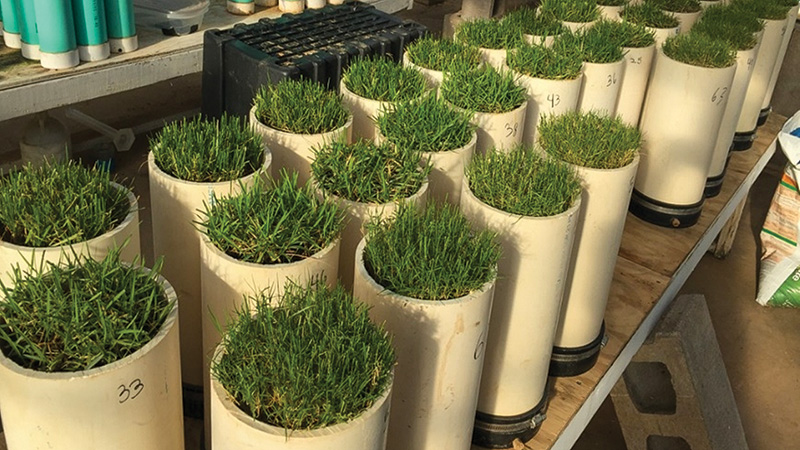
Three turfgrass species were included in this study: Meyer zoysiagrass, Latitude 36 hybrid bermudagrass and Falcon IV tall fescue. All were planted in May 2017.
Materials and methods
A study was conducted at the Oklahoma State University Horticulture Research Greenhouses in Stillwater, Okla. Temperature in the greenhouse was maintained at a 68/86 F (30/20 C) (day/night) regime. Three turfgrass species were included in this study: Meyer zoysiagrass (Zoysia japonica Steud.), OKC1119 (hereafter referred to as Latitude 36 hybrid bermudagrass (Cynodon dactylon × C. transvaalensis) and Falcon IV tall fescue [Schedonorus arundinaceus (Schreb.) Dumort., nom. cons.]. All species were planted in May 2017 and allowed to establish for nine months before applying treatments. Plants were planted in grow tubes (5.9 inches/15 centimeters diameter and 14.17 inches/36 centimeters long) filled with fritted clay (Turface MVP, Profile LLC, Buffalo Grove, Ill.) that had been sieved to a particle size ranging from 0.04 to 0.08 inches (1 to 2 millimeters). Turf was trimmed at 2 inches (5 centimeters) weekly and fertilized every one to two weeks during establishment and the experiment period.
Experiment design
The experiment was arranged as a completely randomized design with four replications. The treatments were structured as a split plot, with the whole main plot being the irradiance factor (shaded or nonshaded) and each of the three species and two irrigation levels arranged factorial within each irradiance intensity. The shade treatment was imposed using black woven shade fabric, nominally rated to reduce incoming radiation by 55%. A 10-foot-by-5-foot (3-meter-by-1.5-meter) section of the shade fabric was suspended approximately 3.3 feet (1 meter) above the pots. Shade fabric was placed on the treatment group on Feb. 8, 2018 (eight weeks prior to initiation of irrigation treatments), and was only removed for data collection, mowing or fertilization (about seven to eight hours per week). Nonshaded pots received 12 hours of supplemental lighting from a high-pressure sodium lamp to increase the daily light integral but not influence photoperiod. The average daily light integral (DLI) of nonshaded pots was 26.0 mol per 10.76 square feet (1 square meter) per day, and the average DLI of shade pots was 11.3 mol per 10.76 square feet (1 square meter) per day.
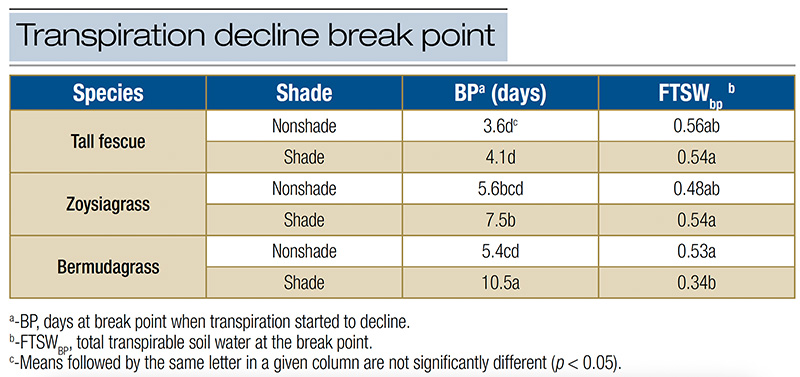
Table 1. Transpiration decline break point (BP) for three turfgrasses under shaded and non-shaded conditions. Note: *-Significant at the 0.05 probability level, **-Significant at the 0.01 probability level, ***-Significant at the 0.001 probability level, ns-Not significant at the 0.05 probability level.
Irrigation treatments were initiated on April 9, 2018, as either (i) well-watered (daily replacement of 100% ET) or (ii) dry-down (water withheld for the remainder of the study). The day before initiating the dry-down treatment, all pots were trimmed and watered to saturation. After 24 hours of drainage, pots were weighed to determine the field capacity weight.
Measurements
After initial saturation and drainage to field capacity, pots were weighed daily at 1 p.m., and ET was calculated as the difference in mass between days. A transpiration ratio (TR) for each treatment combination was calculated as the ET of dry-down pots divided by the average ET of well-watered pots. The study was ended for a particular pot when the TR reached 25%, which ranged from 10 to 28 days after initiating the dry down. The final weight was recorded for each pot and used to calculate the total soil water that could be transpired (7). To describe the relationship between TR and soil water status, the fraction of transpirable soil water (FTSW) was calculated for each measurement day.
Leaf relative water content (RWC) was measured on the second fully expanded leaf from 10 randomly selected shoots per pot. Measurements were timed to occur when the TR reached 100%, 75%, 45% and 25%. Visual estimates of leaf firing were collected daily following the National Turfgrass Evaluation Program guidelines using a 1-to-9 scale (1 = 100% leaf firing, and 9 = no leaf firing). Root dry mass was measured at the conclusion of the study. Roots were washed free of soil, then separated into three depths: 0 to 3.94, 3.94 to 7.87 and 7.87 to 11.81 inches (0 to 10, 10 to 20 and 20 to 30 centimeters). Roots were oven-dried for 48 hours at 176 F (80 C) and weighed.
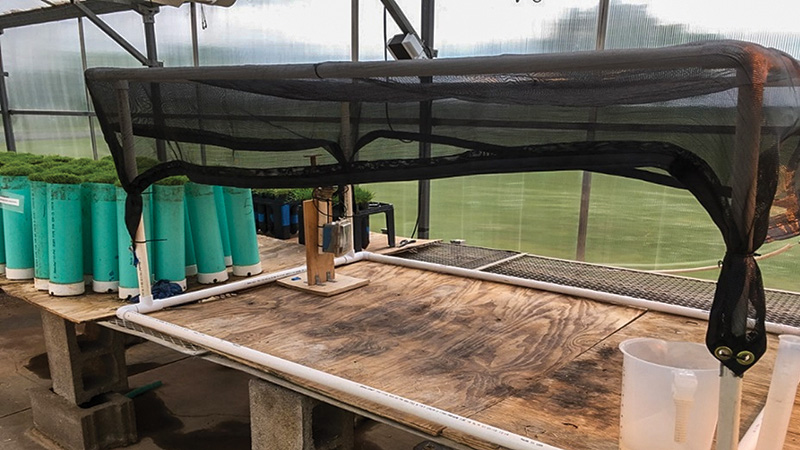
A section of black woven shade fabric was suspended approximately 3.3 feet above the pots. Shade fabric was placed on the treatment group eight weeks prior to initiation of irrigation treatments and was only removed for data collection, mowing or fertilization (about seven to eight hours per week).
Data analysis
The response of transpiration to declining soil water content was analyzed using a segment linear regression model (GraphPad Prism 2.01, Software Inc., San Diego). A separate model was developed for each replication as well as a global model that was fit to the treatment means. The model was used to estimate a break-point parameter for each species. The break point was defined as the FTSW at which normalized TR (NTR) started to decline, which may reflect the water-use pattern and stomatal activity during the soil drying process (7). Measured and derived variables were analyzed using the GLIMMIX procedure (SAS Institute Inc.). Tukey’s HSD method was used to detect significant differences among treatment means at 0.05 probability level.
A nonlinear regression analysis (SPSS) was used to predict leaf firing in response to FTSW. The data were fit to a logistic function having the following formula:
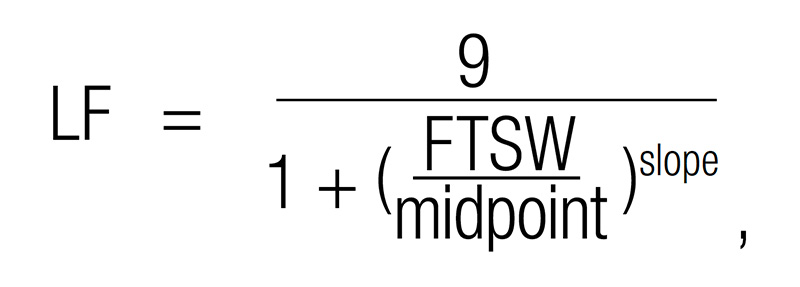
where the midpoint is defined as the point where 50% of leaf firing had occurred, slope was a fitting parameter and 9 was the maximum value for LF.
Data were compared for midpoint, slope and the FTSW required to reach a LF rating of 6.
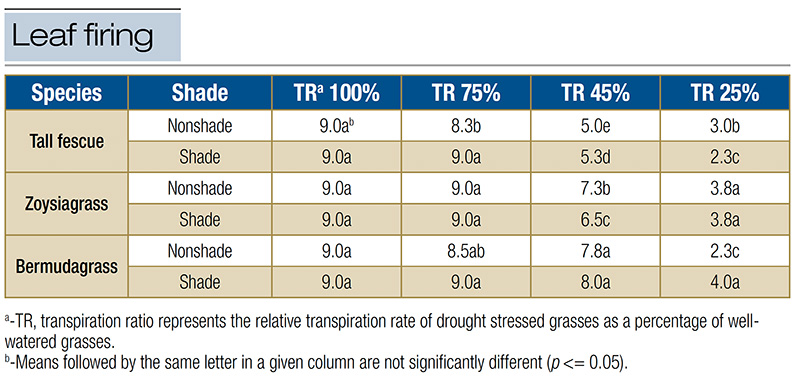
Table 2. Leaf firing of each species in comparison to declining transpiration rates under drought stress.
Results
Transpiration response during soil drying
Shade increased the number of days to reach the BP (point where transpiration began to decline), such that days increased by 0.5, 1.9 and 5.1 days for tall fescue, zoysiagrass and bermudagrass, respectively (Table 1). The NTR was equivalent to well-watered plants until it reached BP, where FTSW ranged from 0.34 for shaded bermudagrass to 0.56 for nonshaded tall fescue. In general, the BP occurred at the same FTSW for each species and irradiance level except for in shaded bermudagrass, which occurred at drier soil conditions.
Leaf firing
In general, tall fescue leaves showed stress more quickly than the warm-season turfgrasses, both in terms of time and progressive decline of TR (Table 2). Shade reduced LF of tall fescue compared to the nonshaded treatment at moderate soil water deficits but increased LF at the final measurement (driest conditions). In contrast, shade reduced LF of bermudagrass at the final measurement (25% TR) but showed no other effects during the dry down. Leaf firing as a function of soil water content (FTSW) was nearly identical for tall fescue and zoysiagrass under shade.
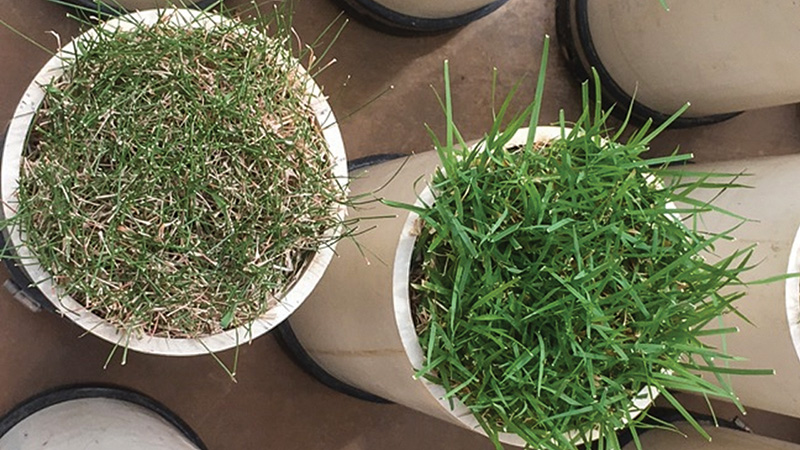
Results suggest shade promotes delays in leaf dehydration, but this does not inherently delay visual indicators of stress (leaf firing) for corresponding soil water conditions.
Leaf relative water content
Shade increased the leaf RWC at 75% TR and decreased it at 45% TR for tall fescue (Table 3). Shade increased RWC for zoysiagrass at 45% TR and for bermudagrass at 45% and 25% TR. The RWC for shaded bermudagrass and zoysiagrass did not decline below 0.71 during the study period. In contrast, nonshaded bermudagrass reached a RWC of 0.55 at the conclusion of the study, while nonshaded zoysiagrass (0.69) ended closer to the same RWC as its shaded counterpart (0.71), although it reached that leaf hydration earlier in the process (45% TR sampling point).
Rooting
The total rooting varied by species in the following order: tall fescue (17.07 ounces per square yard/609.2 grams per square meter) > bermudagrass (15.50 ounces per square yard/525.4 grams per square meter) > zoysiagrass (9.33 ounces per square yard/316.5 grams per square meter) (Table 4). Bermudagrass and zoysiagrass rooting was concentrated in the 0-to-3.94-inch (0-to-10 centimeter) soil depth, while bermudagrass also exhibited 9.4% of total root mass in the deepest depth. In contrast, tall fescue demonstrated a more prolific root system throughout the soil column with 30.2% of total root mass at the 3.94-to-7.87-inch (10-to-20-centimeter) depth and 25.6% at the deepest depth.
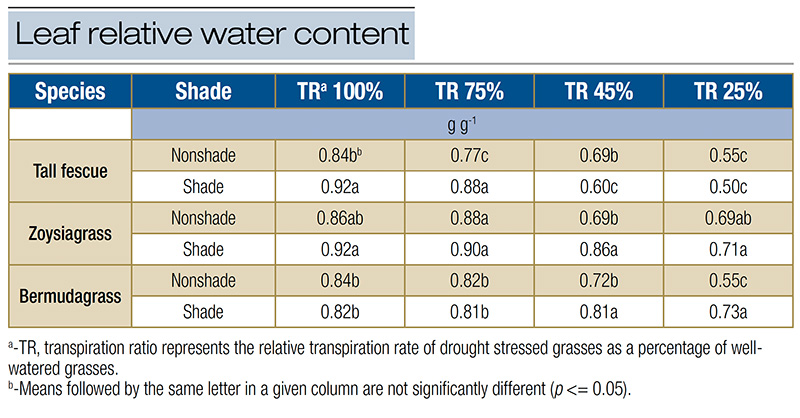
Table 3. Leaf relative water content of each species in comparison to declining transpiration rates under drought stress
Discussion
Stomatal closure due to progressive soil drying starts to occur at the break point (BP) when transpiration rates deviate from well-watered levels (8). Therefore, a BP at a lower soil water condition demonstrates a plant’s ability to sustain normal physiological processes before stomatal closure. In the present study, delayed BP and presumably delayed stomatal closure was evident for bermudagrass under shade, which is likely to be advantageous under short-term drought conditions but less beneficial for longer-duration drought. On the other hand, the lack of a shade effect for zoysiagrass or tall fescue could suggest the response is related to the superior shade tolerance of these species.
The greater ET rate for tall fescue compared to the other grasses is in agreement with well-known differences between warm- and cool-season turfgrasses’ water-use rates. Further, it is thought that differences in rooting can influence the resistance to water movement from soil into the plant (1). This trait seems to be particularly important for extracting water from deeper in the profile. In the present study, the high root mass at the 7.87-to-11.81-inch (20-to-30-centimeter) depth for tall fescue likely increased the extractable water as compared to zoysiagrass, which had the lowest root mass at the 7.87-to-11.81-inch (20-to-30-centimeter) depth. These discrepancies in root mass also illustrate limitations of this experiment, which used an artificially restricted root zone. Conclusions regarding the overall drought resistance under shade should be validated under real-world environments to determine if differences in rooting potential offset other responses to drought and shade.
Results suggest shade promotes delays in leaf dehydration, but this does not inherently delay visual indicators of stress (leaf firing) for corresponding soil water conditions. These findings could point to differences in how plants handle long-term versus short-term droughts.
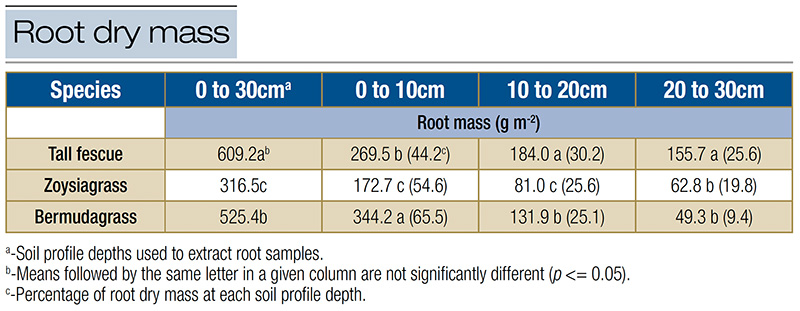
Table 4. Root dry mass at 0~10 cm, 10~20 cm, 20~30 cm and 0~30 cm depths and the percentage of root mass at each depth relevant to the overall rooting.
The research says
- Delayed break point and presumably delayed stomatal closure was evident for bermudagrass under shade, which is likely to be advantageous under short-term drought conditions but less beneficial for longer duration drought.
- The lack of a shade effect for zoysiagrass or tall fescue could suggest the response is related to the superior shade tolerance of these species.
- Results suggest shade promotes delays in leaf dehydration, but this does not inherently delay visual indicators of stress (leaf firing) for corresponding soil water conditions. These findings could point to differences in how plants handle long-term versus short-term droughts.
Acknowledgements
This work was supported in part by the USDA National Institute of Food and Agriculture, Hatch project OKL03039, and the Oklahoma Department of Agriculture, Food, and Forestry Specialty Crop Block Grant. This article summarizes findings previously reported by Duan et al. (5).
Literature cited
- Carrow, R.N. 1996. Drought avoidance characteristics of diverse tall fescue cultivars. Crop Science 36(2):371-377 (https://doi.org/10.2135/cropsci1996.0011183X003600020026x).
- Cathey, S.E., J.K. Kruse, T.R. Sinclair and M.D. Dukes. 2013. Transpiration and visual appearance of warm season turfgrasses during soil drying. Environmental and Experimental Botany 89:36-43 (https://doi.org/10.1016/j.envexpbot.2012.12.004).
- Chhetri, M., C. Fontanier, J.Q. Moss and Y. Wu. 2022. Effects of combined shade and drought stress on turf-type bermudagrasses. International Turfgrass Society Research Journal 14(1):194-204 (https://doi.org/10.1002/its2.68).
- Duan, H., and C. Fontanier. 2022. Effect of acute shade on the canopy morphology and evapotranspiration rates of three turfgrasses. International Turfgrass Society Research Journal 14(1):262-265 (https://doi.org/10.1002/its2.110).
- Duan, H., M. Xiang and C. Fontanier. 2024. Effect of reduced irradiance on drought resistance of three turfgrasses. International Turfgrass Society Research Journal 15(1):1-10 (https://doi.org/10.1002/its2.170).
- Fontanier, C., B. Cheary and N. Amgain. 2021. Effect of shade on water use rates of selected amenity turfgrasses. Page 1. In: 6th Decennial National Irrigation Symposium, 6-8, December 2021, San Diego. American Society of Agricultural and Biological Engineers.
- Fuentealba, M.P., J. Zhang, K. Kenworthy, J. Erickson, J. Kruse and L. Trenholm. 2016. Transpiration responses of warm-season turfgrass in relation to progressive soil drying. Scientia Horticulturae 198:249-253 (https://doi.org/10.1016/j.scienta.2015.11.042).
- Miller, G.L. 2000. Physiological response of bermudagrass grown in soil amendments during drought stress. HortScience 35(2):213-216 (https://doi.org/10.21273/HORTSCI.35.2.213).
- Sade, N., A. Gebremedhin and M. Moshelion. 2012. Risk-taking plants: Anisohydric behavior as a stress-resistance trait. Plant Signaling & Behavior 7(7):767-770 (https://doi.org/10.4161/psb.20505).
Huanyun Duan is a former graduate student in Charles Fontanier’s lab in the Horticulture and Landscape Architecture (HLA) Department; Mingying Xiang is an assistant professor of turfgrass stress physiology in HLA; and Charles Fontanier (charles.fontanier@okstate.edu) is an associate professor of turfgrass management in HLA, all at Oklahoma State University, Stillwater